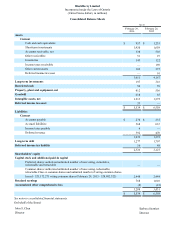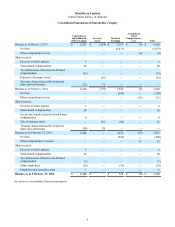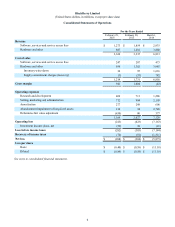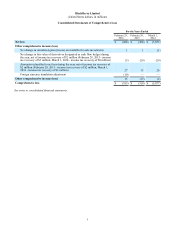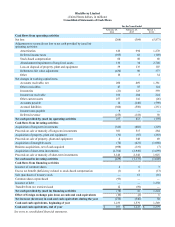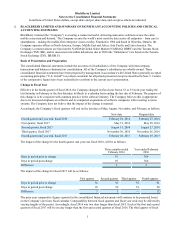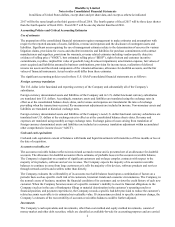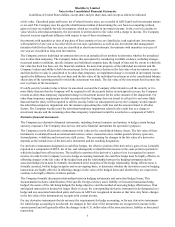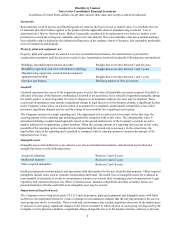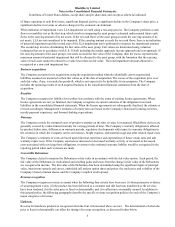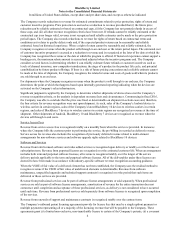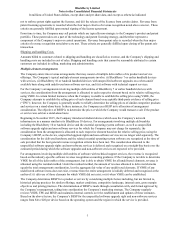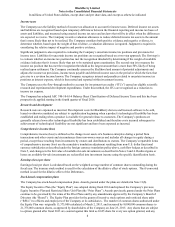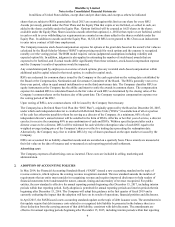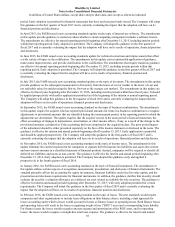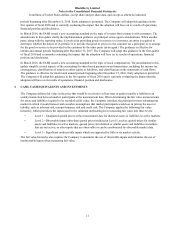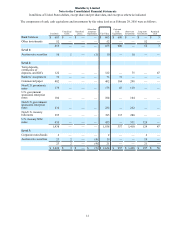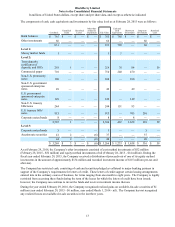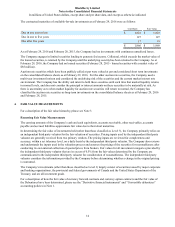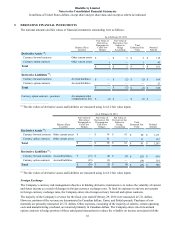Blackberry 2016 Annual Report Download - page 74
Download and view the complete annual report
Please find page 74 of the 2016 Blackberry annual report below. You can navigate through the pages in the report by either clicking on the pages listed below, or by using the keyword search tool below to find specific information within the annual report.
BlackBerry Limited
Notes to the Consolidated Financial Statements
In millions of United States dollars, except share and per share data, and except as otherwise indicated
6
The Company records reductions to revenue for estimated commitments related to price protection, rights of return and
customer incentive programs. Price protection is accrued as a reduction to revenue provided that (i) the future price
reduction can be reliably estimated or based on contractual caps, (ii) the Company has not granted refunds in excess of
those caps, and (iii) all other revenue recognition criteria have been met. If refunds cannot be reliably estimated or the
contractual cap is no longer valid, revenue is not recognized until reliable estimates can be made or the price protection
period lapses. The Company also records reductions to revenue for rights of return based on contractual terms and
conditions as it relates to quality defects only and, if the expected product returns can be reasonably and reliably
estimated, based on historical experience. Where a right of return cannot be reasonably and reliably estimated, the
Company recognizes revenue when the product sells through to an end user or the return period lapses. The estimated cost
of customer incentive programs is accrued as a reduction to revenue and is recognized at the later of the date at which the
Company has recognized the revenue or the date at which the program is offered. If historical experience cannot support a
breakage rate, the maximum rebate amount is accrued and adjusted when the incentive programs end. The Company
considers several factors in determining whether it can reliably estimate future refunds or customer incentives such as
levels of channel inventory, new competitor introductions, the stage of a product in the product life cycle, and potential
cannibalization by future product offerings. If there is a risk of future pricing concessions and a reliable estimate cannot
be made at the time of shipment, the Company recognizes the related revenue and costs of goods sold when its products
are sold through to an end user.
For shipments where the Company recognizes revenue when the product is sold through to an end user, the Company
determines the point at which that happens based upon internally generated reporting indicating when the devices are
activated on the Company’s relay infrastructure.
Significant judgment is applied by the Company to determine whether shipments of devices have met the Company’s
revenue recognition criteria, as the analysis is dependent on many facts and circumstances. Commencing in fiscal 2016,
the Company was able to conclude that the price was fixed or determinable on shipment in certain cases and, therefore,
the four criteria for revenue recognition were met upon shipment. As such, sales of the Company’s Android device to
wireless carriers in certain regions, sales of the Company’s latest BlackBerry 10 devices to wireless carriers in certain
regions, and sales of BlackBerry 7 devices to wireless carriers in certain regions are recognized as revenue at the time of
shipment. Other shipments of Android, BlackBerry 10 and BlackBerry 7 devices are recognized as revenue when the
devices sell through to end users.
Service Access Fees
Revenue from service access fees is recognized ratably on a monthly basis when the service is provided. In instances
where the Company bills the customer prior to performing the service, the pre-billing is recorded as deferred revenue.
Service access fee revenue also includes the recognition of previously deferred revenue related to multi-element
arrangements for non-software services and software upgrade rights related to BlackBerry 10 devices.
Software and Services
Revenue from term licensed software and value added services is recognized upon delivery or ratably over the license or
subscription term. Revenue from perpetual licenses are recognized over the estimated customer life. When an arrangement
includes both term and perpetual software licenses, all revenue is recognized ratably over the longer of the service
delivery periods applicable to the term and perpetual software licenses. All of the deliverables under these licenses are
deemed to have been made in accordance with industry-specific software revenue recognition accounting guidance.
When the VSOE of fair value of a delivered element has not been established, the Company uses the residual method to
recognize revenue if the VSOE of fair value of undelivered elements is determinable. Revenue from software
maintenance, unspecified upgrades and technical support contracts is recognized over the period that such items are
delivered or those services are provided.
Revenue from professional services can be part of software license arrangements or sold separately. When professional
services are sold as part of software license arrangements, amortization of revenue for the entire transaction does not
commence until completion and acceptance of these professional services, as delivery is not considered to have occurred
until such time. Revenue from professional services sold separately from software licenses is recognized upon completion
of the services.
Revenue from renewals of support and maintenance contracts is recognized ratably over the contract term.
The Company’s outbound patent licensing agreements provide for license fees that may be a single upfront payment or
multiple payments representing all or a majority of the licensing revenue that will be payable to the Company. These
agreements grant (i) a limited non-exclusive, non-transferable license to certain of the Company’s patents, (ii) a covenant


